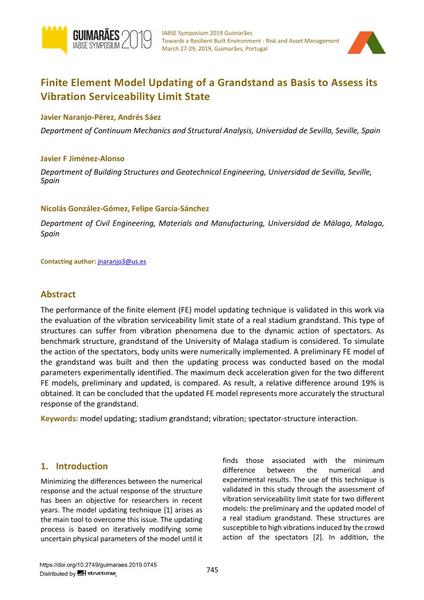Finite Element Model Updating of a Grandstand as Basis to Assess its Vibration Serviceability Limit State

|
|
|||||||||||
Bibliographic Details
| Author(s): |
Javier Naranjo-Pérez
(Department of Continuum Mechanics and Structural Analysis, Universidad de Sevilla, Seville, Spain)
Andrés Sáez Javier F. Jiménez-Alonso (Department of Building Structures and Geotechnical Engineering, Universidad de Sevilla, Seville, Spain) Nicolás González-Gómez (Department of Civil Engineering, Materials and Manufacturing, Universidad de Málaga, Malaga, Spain) Felipe García-Sánchez (Department of Civil Engineering, Materials and Manufacturing, Universidad de Málaga, Malaga, Spain) |
||||
|---|---|---|---|---|---|
| Medium: | conference paper | ||||
| Language(s): | English | ||||
| Conference: | IABSE Symposium: Towards a Resilient Built Environment Risk and Asset Management, Guimarães, Portugal, 27-29 March 2019 | ||||
| Published in: | IABSE Symposium Guimarães 2019 | ||||
|
|||||
| Page(s): | 745-751 | ||||
| Total no. of pages: | 7 | ||||
| DOI: | 10.2749/guimaraes.2019.0745 | ||||
| Abstract: |
The performance of the finite element (FE) model updating technique is validated in this work via the evaluation of the vibration serviceability limit state of a real stadium grandstand. This type of structures can suffer from vibration phenomena due to the dynamic action of spectators. As benchmark structure, grandstand of the University of Malaga stadium is considered. To simulate the action of the spectators, body units were numerically implemented. A preliminary FE model of the grandstand was built and then the updating process was conducted based on the modal parameters experimentally identified. The maximum deck acceleration given for the two different FE models, preliminary and updated, is compared. As result, a relative difference around 19% is obtained. It can be concluded that the updated FE model represents more accurately the structural response of the grandstand. |
||||
| Keywords: |
vibration model updating stadium grandstand spectator-structure interaction
|
||||
